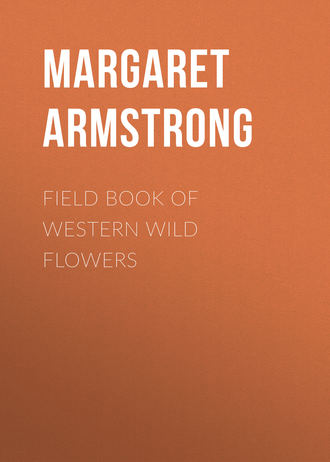 полная версия
полная версияField Book of Western Wild Flowers

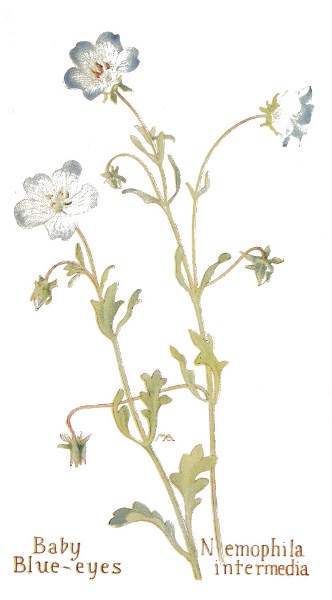
Baby Blue-eyes – Nemophila intermedia.

Spotted Nemophila – N. maculata.
Baby Blue-eyes – Nemophila insignis.

Climbing Nemophila
Nemóphila aurìta
Purple
Summer
California
This is a straggling plant, with pretty delicate flowers, which suggest some sort of Nightshade. The stems are pale, square, juicy and very brittle, from one to three feet long, and the leaves are bright green and most of them are alternate, with leafstalks which are winged and clasping at base. The backs of the leaves, and the stems and calyxes, are covered with hooked bristles, which enable the plant to climb over its neighbors and give it the feeling of Bed-straw to the touch. The flowers are nearly an inch across, with purple corollas, shading to white in the center and paler outside, with purple scales in the throat and purple stamens. This is rather coarser than most Nemophilas and grows in light shade on hillsides.
There are several kinds of Conanthus, low hairy herbs, with alternate, toothless leaves. The calyx and corolla are without appendages; the stamens are not protruding, and are unequal in length and unequally inserted in the tube of the corolla; the style is two-lobed and the capsule is roundish and contains from ten to twenty, smooth seeds.
Conanthus
Conánthus aretioìdes
Pink
Spring
Idaho, Nev., Ariz.
This is a pretty little desert plant, spreading its branches flat on the ground and bearing tufts of grayish-green, very hairy foliage and a number of charming little flowers, which are three-eighths of an inch across, with very hairy calyxes and bright purplish-pink corollas, with a white and yellow "eye" and a long, slender, yellow tube, which is slightly hairy on the outside. The styles and anthers are of various lengths in different plants. These gay little flowers look very pretty on the dreary mesas around Reno and suggest some sort of Gilia.

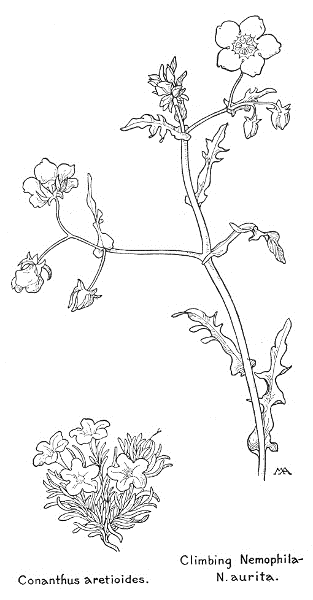
Conanthus aretioides.
Climbing Nemophila – N. aurita.
There are only two kinds of Romanzoffia.
Romanzoffia
Romanzóffia sitchénsis
White
Summer
Northwest, etc.
This is a charming little perennial plant, which forms beautiful clumps of delicate foliage and flowers, suggesting some sort of Saxifrage. The many, smooth, slender, pale green stems, from four to nine inches tall, spring from slender, threadlike rootstocks, bearing tubers, and the leaves are mostly from the root, smooth, bright green, and prettily scalloped, with long leaf-stalks. The flowers are in loose clusters and are each half an inch or more long, with a white corolla, which is without appendages inside and is exceedingly beautiful in texture, with yellow stamens, unequally inserted, and a long, threadlike style, with a small stigma. These little plants grow in moist, shady spots among the rocks, as far north as Alaska and often reach very high altitudes, where it is a delight to find their pearly flowers and lovely foliage in some crevice in the cliffs watered by a glacier stream. These plants are found as far north as Alaska and were named in honor of Count Romanzoff, who sent the Kotzebue expedition to Alaska.
There are several kinds of Emmenanthe, much like Phacelia, but the stamens not protruding, and the corolla bell-shaped, cream-color or yellow, becoming papery in withering and not falling off, hence the Greek name, meaning "lasting flower."
Emmenanthe
Emmenánthe lùtea
Yellow
Spring, summer
Idaho, Nev., etc.
A low plant, with many, downy branches, spreading almost flat on the ground, and small, thickish leaves, light dull green, and slightly downy. The flowers are rather more than a quarter of an inch across, with hairy calyxes, and bright yellow corollas, hairy outside, with ten little appendages inside, and grow in coiled clusters. The little flowers are gay and pretty and look bright and cheerful on the desert sands where they live. This is found as far east as Oregon.
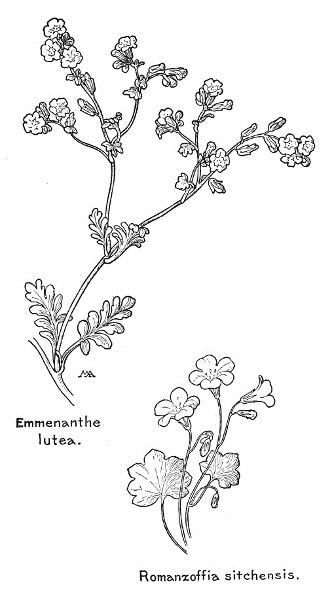
Emmenanthe lutea.
Romanzoffia sitchensis.
Whispering Bells
Emmenánthe penduliflòra
Yellowish
Spring, summer
Southwest
Pretty plants, from eight to fourteen inches tall, with branching, hairy stems and light green, soft, downy leaves. The flowers are less than half an inch long, with pale yellow corollas, and are at first erect, but gradually droop until they hang gracefully on their very slender pedicels. They become dry and papery as they wither, but keep their form, and when the wind shakes their slender stems they respond with a faint rustling sound. This grows in dry places and is common in the South. In Arizona it grows only in protected canyons.
There are several kinds of Hydrophyllum, perennial or biennial herbs, with fleshy running rootstocks and large, more or less divided leaves, mostly alternate. The corolla is bell-shaped, with a honey-gland at the base of each of the petals, which are rolled up in the bud. The filaments are hairy, the style two-cleft above, both stamens and style are generally long and protruding, and the ovary is one-celled and hairy, containing from one to four seeds.
Cat's Breeches, Waterleaf
Hydrophýllum capitàtum
Lilac
Spring
Northwest, Utah
This is a pretty plant, from six to twelve inches high, with a rather weak stem and conspicuous leaves, which are alternate, pale green, soft and downy, or hairy, with five or seven divisions, prettily lobed and cut, with rather prominent veins, and long, succulent, pinkish leafstalks, sheathing the stem. The flowers are rather small, with short pedicels, and a number are crowded together in roundish clusters, about an inch across, with almost no flower-stalk. The calyx is covered with white hairs, the corolla is lilac or white, somewhat hairy on the outside, and the stamens and style are long and conspicuous, sticking out like cats' whiskers and giving a pretty feathery appearance to the whole cluster, which becomes in fruit a conspicuous, very fuzzy, round head, covered with bristly white hairs, making the children's quaint common name for this plant quite appropriate. It grows in rich soil, in mountain woods, and is one of the earliest spring flowers. It is sometimes called Bear's Cabbage, but this name is far fetched, both as regards bears and cabbages!
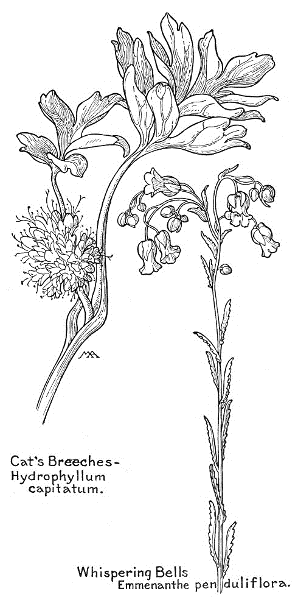
Cat's Breeches – Hydrophyllum capitatum.
Whispering Bells – Emmenanthe penduliflora.
There are several kinds of Eriodictyon, shrubs, with alternate, toothed, leathery, evergreen leaves, which are netted-veined, generally green and smooth on the upper side and whitish and downy on the under, with leaf-stalks; the flowers in coiled clusters; the corolla more or less funnel-form or salver-form, without appendages in the tube; the stamens and the two distinct styles not protruding; the capsule small, with few seeds. The name is from the Greek for "wool" and "net," in allusion to the netted wool on the under surface of the leaves.
Yerba Santa, Mountain Balm
Eriodíctyon Califórnicum
White, lilac
Summer
Cal., Oreg., Wash.
A branching shrub, from two to six feet high, with thickish leaves, with toothed or wavy margins, from two to six inches long, dark and shiny on the upper side, pale with close down and netted-veined on the underside. The flowers are not especially pretty, about half an inch long, with white, lilac, or purple corollas, and are slightly sweet scented. The leaves are strongly and pleasantly aromatic when they are crushed and were used medicinally by the Indians, hence the Spanish name, meaning "holy herb." Cough-syrup is made from them and also substitutes for tobacco and hops. This grows on dry hills and is very variable, being sometimes a handsome shrub. There are intermediate forms between this and the next, E. tomentosum, which are difficult to distinguish.
Woolly Yerba Santa
Eriodíctyon tomentòsum
Lilac
Spring
California
A large leafy shrub, about five feet high and much handsomer than the last, with velvety, light green branches and very velvety, purplish twigs. The beautiful leaves are veined like chestnut leaves and made of the thickest, softest, sea-green or gray velvet, like a mullein leaf in texture, but much smoother and softer. The flowers are three-quarters of an inch long, with a pale pinkish-lilac corolla, shading to purple and white, downy on the outside, and form quite handsome clusters, mixed with pretty gray velvet buds, the lilac of the flowers harmonizing well with the gray foliage. This grows in quantities on Point Loma, and other places along the coast, from San Diego to Santa Barbara. There are several similar varieties.
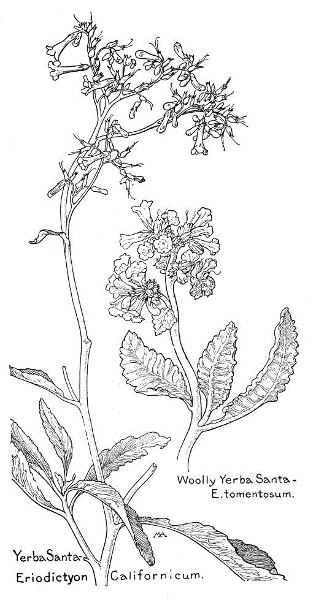
Woolly Yerba Santa – E. tomentosum.
Yerba Santa – Eriodíctyon Californicum.
BORAGE FAMILY. Boraginaceae
A large family, widely distributed, chiefly rough-hairy herbs, without stipules; usually with alternate, toothless leaves; flowers usually in coiled, one-sided clusters; calyx usually with five sepals; corolla usually symmetrical, with five united petals, often with crests or appendages in the throat; stamens five, inserted in the tube of the corolla, alternate with its lobes; ovary superior, with a single, sometimes two-cleft, style, and usually deeply four-lobed, like that of the Mint Family, forming in fruit four seed-like nutlets. Mature fruit is necessary to distinguish the different kinds. These plants superficially resemble some of the Waterleaf Family, but the four lobes of the ovary are conspicuous.
There are many kinds of Lappula, chiefly of the north-temperate zone; leaves narrow; corolla blue or white, salver-form or funnel-form, with a very short tube, the throat closed by five short scales, the stamens, with short filaments, hidden in the tube; ovary deeply four-lobed; style short; nutlets armed with barbed prickles, forming burs, giving the common name, Stickseed, and the Latin name, derived from "bur." Some of them resemble Forget-me-nots, but are not true Myosotis.
White Forget-me-not
Láppula subdecúmbens
White
Spring, summer
Northwest
Though the foliage is harsh, this plant is so graceful and has such pretty flowers that it is most attractive. It is from ten to eighteen inches tall, with several yellowish, hairy stems, springing from a perennial root and a cluster of root-leaves, the stem-leaves more or less clasping at base, all bluish-green, covered with pale hairs, with prominent veins on the back and sparse bristles along the edges. The flowers form handsome, large, loose clusters and the hairy buds are tightly coiled. The calyx is hairy, with blunt lobes, and the corolla, about half an inch across, is pure white, or tinged with blue, often marked with blue, with two ridges on the base of each petal, and the throat closed by five yellow crests, surrounded by a ring of fuzzy white down. This grows on dry plains and hillsides, sometimes making large clumps.
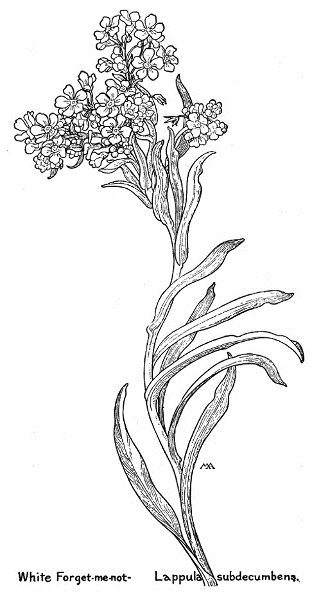
White Forget-me-not – Lappula subdecumbens.
Wild Forget-me-not
Láppula velùtina
Blue
Summer
California
Beautiful flowers, resembling true Forget-me-nots, but larger, with velvety, often reddish stems, from one to two feet tall, velvety leaves, and flowers in handsome, loose, somewhat coiling clusters. The corolla is about half an inch across, sky-blue, the most brilliant blue of any flower in Yosemite, with five, white, heart-shaped crests in the throat; the buds pink. This is rather common in the Sierra Nevada at moderate altitudes. L. nervòsa, of high altitudes, is similar, but with smaller flowers, the leaves rough-hairy, but green. This has very prickly nutlets, which stick in the wool of sheep and are dreaded by shepherds. L. floribúnda, also growing in the mountains of California and Oregon, has similar, small, blue flowers, sometimes pink, and hairy, gray foliage. L. Califórnica, of the northern Sierra Nevada mountains, has small white flowers.
There are many kinds of Lithospermum, chiefly of the northern hemisphere; with reddish, woody roots, hairy leaves, without leaf-stalks, and flowers crowded in clusters, mixed with leaves and leafy bracts; corolla funnel-form or salver-form, the throat often hairy or crested; stamens with short filaments, not protruding from the throat of the corolla; ovary four-lobed, with a slender style, stigma with a round head or two lobes; nutlets usually white and smooth. The Greek name means "stony seed." Puccoon is the Indian name, and these plants are also called Gromwell, and sometimes Indian Dye-stuff, because the Indians made dye from the roots, which yield a beautiful delicate purple color.
Hairy Puccoon
Lithospérmum pilòsum
Yellow
Spring, summer
Northwest, Utah, etc.
A rather pretty plant, about a foot tall, with several, stout, yellowish-green stems, covered with white hairs and very leafy, springing from a thick perennial root. The leaves are bluish-gray green and downy, harsh on the under side, and the flowers are numerous and pleasantly scented, with a very hairy calyx and a salver-form corolla, about three-eighths of an inch across, silky outside, the throat downy inside, but without crests. The flowers are yellow, an unusual shade of pale corn-color, and harmonize with the pale foliage, but are not conspicuous, and the flower cluster is so crowded with leaves and leafy bracts that it is not effective. This grows in dry fields, as far east as Nebraska, and sometimes makes pretty little bushes, over two feet across.
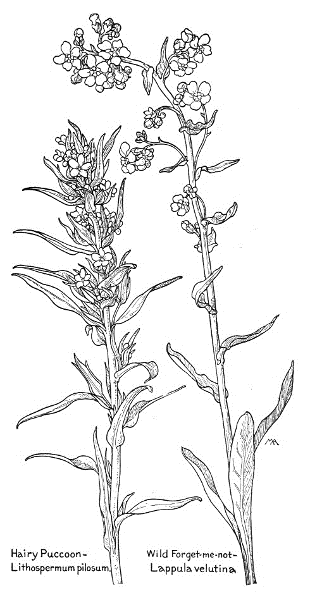
Hairy Puccoon – Lithospermum pilosum.
Wild Forget-me-not – Lappula velutina.
Pretty Puccoon
Lithospérmum angustifòlium
Yellow
Spring
West, etc.
These are pretty flowers, but have a disagreeable smell. They are perennials, with a deep root and hairy or downy, branching stems, from six inches to two feet high, and hairy or downy leaves, which are rather grayish green. The flowers are in terminal leafy clusters and are of two sorts. The corollas of the earlier ones are very pretty, clear bright yellow, sometimes nearly an inch and a half long, with toothed lobes, which are charmingly ruffled at the edges, and with crests in the throat, but the later flowers are small, pale, and inconspicuous. This grows in dry places, especially on the prairies, and is very widely distributed in the western and west central states.
Gromwell
Lithospérmum multiflòrum
Yellow
Summer
Ariz., Utah, etc.
This has a rough, hairy stem, about a foot tall, and dull green, rough, hairy leaves, with bristles along the edges. The yellow flowers are half an inch long and form rather pretty coiled clusters. This grows in open woods at the Grand Canyon, and is found as far east as New Mexico and Colorado.
There are a good many kinds of Amsinckia, natives of the western part of our country and of Mexico and South America. They are rather difficult to distinguish, rough, hairy or bristly, annual herbs, the bristles usually from a raised base, and with yellow flowers, in curved, rather showy, clusters. The corolla is more or less salver-form, without crests, but with folds; the stamens and pistil not protruding, the stigma two-lobed. In order to insure cross pollination by insects, in some kinds the flowers are of two types, as concerns the insertion of the stamens on the corolla and the length of the style. Several of these plants are valuable in Arizona for early spring stock feed, and the leaves of young plants are eaten by the Pima Indians for greens and salads.
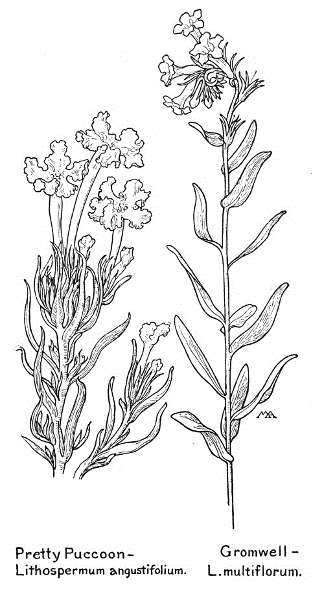
Pretty Puccoon – Lithospermum angustifolium.
Gromwell – L. multiflorum.
Saccato Gordo, Fiddle-neck, Buckthorn Weed
Amsínckia inlermèdia
Yellow
Spring, summer
West
This has bright flowers, but the foliage is dreadfully harsh. The stem is from one to three feet tall, often widely branching, with white bristles scattered over it, and the leaves are dull green and bristly. The flowers are pretty, about half an inch long, with narrow sepals and bright orange corollas, with five bright red spots between the lobes. The nutlets are roughened with short, hard points. These plants are very common and sometimes form rank thickets in fields and waste places. They are very abundant in southern Arizona and are valued as a grazing plant for stock and are therefore known as Saccato Gordo, which means "fat grass."
There are many kinds of Cryptanthe, most of them western and difficult to distinguish. They are slender, hairy plants, with small flowers, which are usually white, in coiled clusters; the calyx bristly; the corolla funnel-form, usually with five crests closing the throat; the nutlets never wrinkled. These plants resemble white Forget-me-nots and are sometimes so called. The Greek name means "hidden flower," perhaps because of the minute flowers of some kinds.
Nievitas
Cryptánthe intermèdia
White
Spring
Cal., Ariz.
A rather attractive little plant, but inconspicuous except when it grows in patches, when it powders the fields with white, like a light fall of snow, and suggests the pretty Spanish name, which is a diminutive of "nieve," or snow. The slender, roughish stem is about ten inches tall, the light green leaves are hairy, with fine bristles along the edges, and the pretty little flowers are white, about a quarter of an inch across, with yellow crests in the throat. Popcorn Flower, Plagiobòthrys nothofúlvus, of the Northwest, is also called Nievitas, as it often whitens the ground with its small, fragrant, white flowers, which are very much like the last.

Nievitas – Cryptanthe intermedia.
Saccato Gordo – Amsinckia intermedia.
There are a good many kinds of Mertensia, natives of the northern hemisphere. They are handsome perennials, never very hairy and sometimes perfectly smooth all over, with leafy stems and broad leaves, sometimes dotted, the lower ones with leaf-stalks. The pretty, nodding flowers are in clusters and have a purple, blue, or white corolla, often turning pink, more or less trumpet-shaped, the lobes not spreading much, the throat open, with or without crests; the ovary deeply four-lobed, with a threadlike style and one stigma; the nutlets wrinkled. These plants are all commonly called Lungwort.
Languid Lady, Lungwort
Merténsia Sibírica
Blue
Summer
Northwest
A very attractive and graceful mountain plant, with pretty flowers and fine foliage. The stems are hollow and usually smooth, from one to five feet tall, and the leaves are rather thin and soft in texture, usually smooth, with a "bloom." The flowers are in handsome loose clusters, most of them drooping, and have a corolla over half an inch long, which is a beautiful shade of bright light blue, often tinged with pink, with white crests in the throat, and the style is long and protruding. The buds are bright pink, contrasting well with the blue flowers. This grows near streams, in the higher mountains. It is often called Mountain Bluebell, but that name belongs to Campanula and is therefore misleading. (This has recently been "separated" into several species.)
Lungwort
Merténsia brevístyla
Blue
Spring, summer
Utah, Col., Wyo.
This is an attractive plant and looks a good deal like a Forget-me-not. It grows from four to ten inches tall and has dull bluish-green leaves, which are downy on the upper side and smooth on the under, and graceful clusters of pretty little flowers. The buds are pinkish-purple and the flowers are small, with hairy calyxes and brilliant sky-blue corollas, the stamens and style not protruding. This grows in mountain canyons, up to an altitude of seven thousand feet.
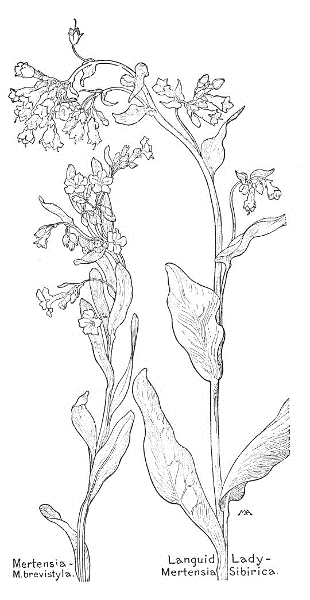
Mertensia – M. brevistyla.
Languid Lady – Mertensia Sibirica.
There are many kinds of Heliotrope, widely distributed in temperate and tropical regions; ours have small, white or blue flowers, in coiled spikes; the corolla salver-form or funnel-form, without crests or hairs; the stamens not protruding, the filaments short or none, the anthers sometimes joined by their pointed tips; the ovary not four-lobed, but sometimes grooved, with a short style, the stigma cone-shaped or round.
Sea-side Heliotrope, Chinese Pusley
Heliotròpium Curassávicum
White
Summer, autumn
Cal., Oreg., etc.
This is not a pretty plant and is rather insignificant because of its dull coloring. It forms low, branching, straggling clumps, with thickish stems and leaves, which are succulent and perfectly smooth, with a "bloom," and the flowers are small, the corolla white or pale lilac, with a yellow "eye" which changes to purple, forming crowded coiled spikes, mostly in pairs, without bracts. The fruit consists of four nutlets. This is widely distributed, in moist, salty or alkaline places, growing also in the East and in South America and the Old World.
There are several kinds of Oreocarya, natives of western North America and Mexico, coarse, hairy, perennial or biennial herbs, with thick woody roots; the leaves narrow, alternate or from the root; the flowers small, mostly white, in clusters, with a funnel-form or salver-form corolla, usually with crests and folds in the throat; the stamens not protruding; the style usually short. The name is from the Greek, meaning "mountain-nut," which does not seem very appropriate.
Oreocarya
Oreocàrya multicàulis
White
Spring
Ariz., Utah, etc.
A rather pretty plant, about six inches tall, not rough and harsh like most kinds of Oreocarya, for the pale grayish-green stem and leaves are covered with white down. The flowers are quite pretty, about three-eighths of an inch across, with white corollas, with yellow crests in the throat. This is found as far east as southern Colorado and New Mexico. O. setosíssima is quite tall, growing in the Grand Canyon, and has a large cluster of small white flowers and is harsh and hairy all over, covered with such long stiff white hairs as to make it conspicuous and very unpleasant to touch.

